Even though latex mattresses are hypoallergenic, over time, allergens and stains will still build up due to accumulated dirt and spills. A build-up of dust, dust mites and mould can worsen allergies, so it’s important to know how to clean a latex mattress.
What you may not know is according to WHO, dust mites account for 70% of all respiratory allergies. So ask yourself, how long has it been since you cleaned your latex mattress? Be honest!
A dirty mattress can lead to allergies kicking off, and may reduce your mattress’s lifespan. So, let’s get your latex mattress back on track and clean as a whistle.
Latex Mattress Cleaning – What Materials Do You Need?
Don’t worry. It’s not much! Most of the items will most likely be in your mattress cleaning stash. If not, we included some recommendations from known retailers.
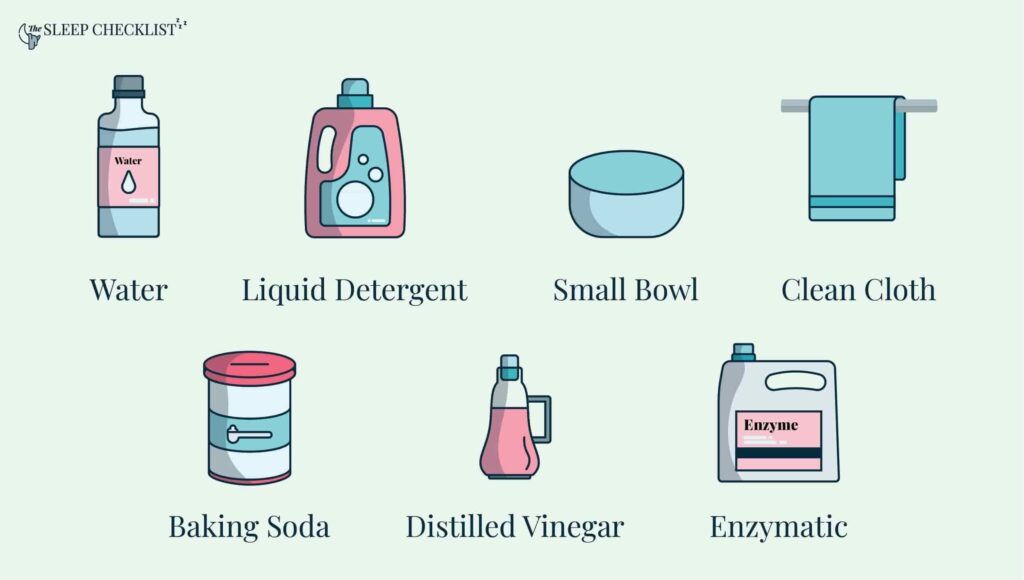
- Water
- Mild or natural liquid detergent
- Small bowl or container
- Clean cloth
- Baking soda
- Distilled vinegar
- Enzymatic cleaner
How To Clean A Latex Mattress? Including Common Spills and Stains
Did you know latex is antimicrobial? This, along with its dense structure, means it’s harder for the dust and mould to penetrate. It also means cleaning lice from your mattress, bed bugs, and dust mites is easier.
They need fewer deep cleaning sessions than other mattress types. Although, if stains are left for too long, they’ll become irremovable.
Method 1: Mild detergent and cold water
Natural latex mattress benefits include the use of organic materials, but watch out as that can be ruined using strong chemicals. Keep clear of chlorine or bleach cleaners like Clorox, as they can cause damage.
When cleaning, use only mild and natural ingredients to avoid damaging the material and reduce its longevity. These include baking soda, vinegar, water, mild detergent, and natural enzyme cleaners.
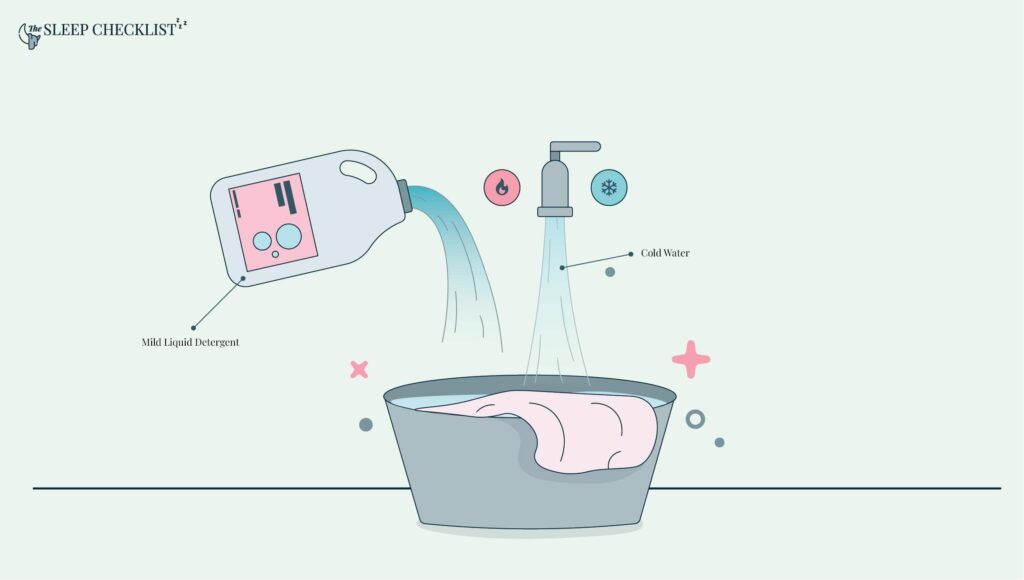
- Mix a few drops of mild liquid detergent and cold water in a small container. We recommend Neutral 0% Sensitive White Washing and ZERO (Non-Bio) Washing Powder.
- Using your fingers, dip a clean cloth into the soapy mixture. Squeeze out any excess liquid.
- Gently rub over the stained area until the stain is lifted.
- Using another cold-water damp cloth, evenly spread the soapy liquid on the mattress.
- Repeat steps 2 to 4 until you’re satisfied with removing stains.
Method 2: Vinegar and cold water
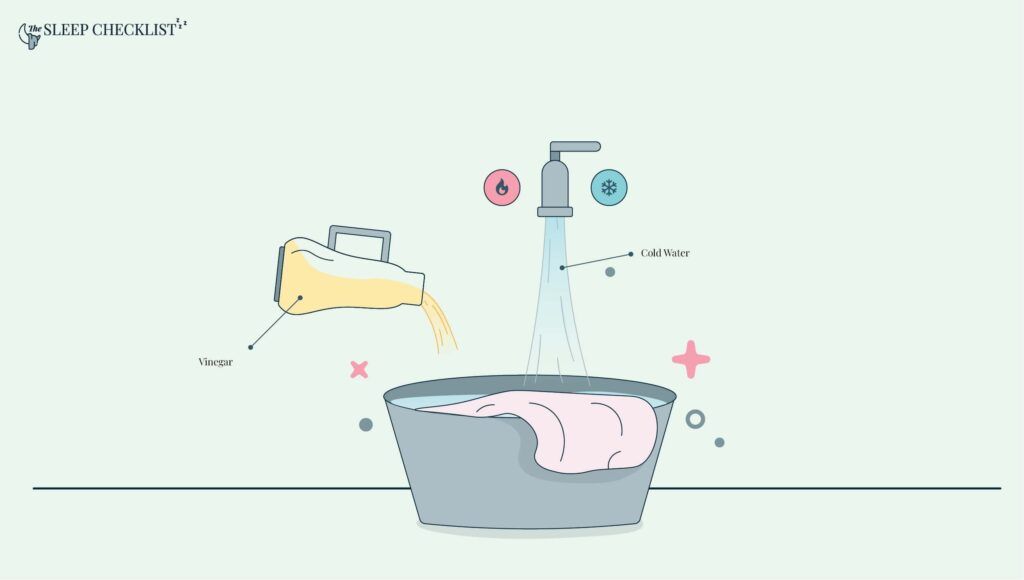
- Mix equal parts of distilled vinegar and col water in a small container. Vinegar acts like acid and will break down stains on your mattress. Cold water ensure stains made from proteins don’t set further into the mattress.
- Dampen a clean cloth with the vinegar mixture and squeeze out any excess liquid.
- Gently rub over the stained area.
- Dampen another clean cloth with cold water and wipe off the vinegar mixture
- Repeat steps 2 to 4 until all stains are lifted.
Method 3: Baking soda and vinegar
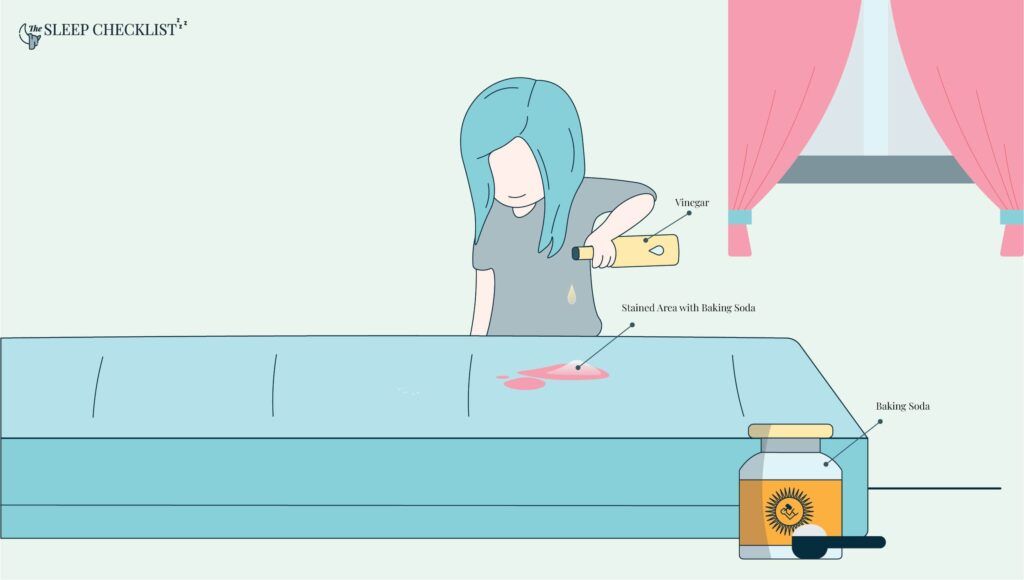
- Sprinkle baking soda on the surface of the mattress or stained area
- Put a few drops of white vinegar on the baking soda. Once baking soda and vinegar mix, it will bubble up but don’t worry this won’t damage the latex. Baking soda is mild and strong enough to lift the stains.
- Dampen another clean cloth with cold water and wipe the mixture.
- Repeat steps 1 to 3 until the stain is completely removed.
Method 4: Hydrogen Peroxide, Dish Soap And Water
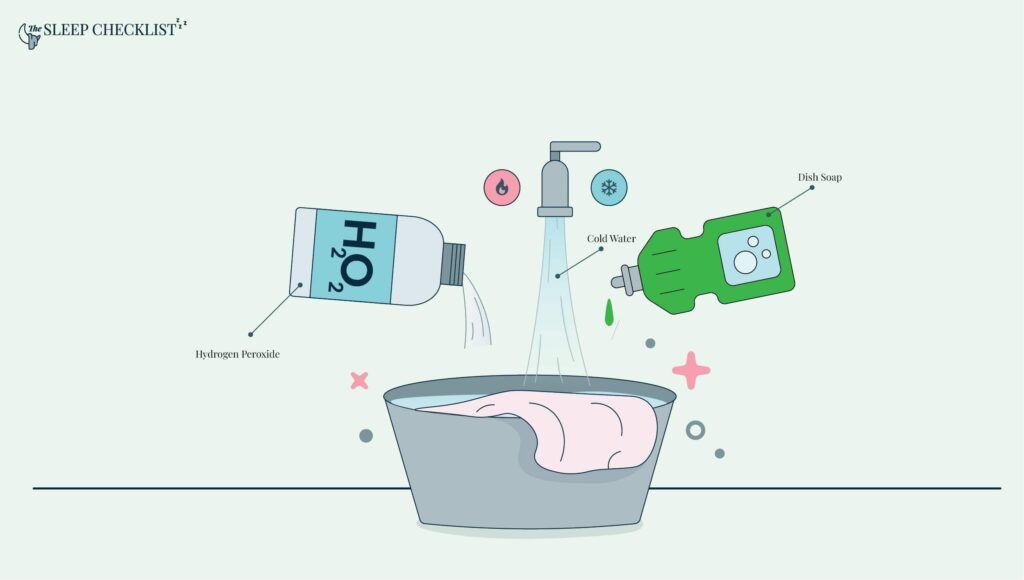
A 3% hydrogen peroxide solution mixed with water and a few drops of dish soap effectively removes dried-on stains onto your mattress, working particularly well with dried pee stains and yellow stains.
Make sure to test the solution on the side of your mattress for discolouration or damage to the latex. If all is good, then:
- Spray onto the stained area
- Leave for 10 – 20 minutes
- Blot the area with a clean cloth
- Rinse with clean water
- Repeat as necessary
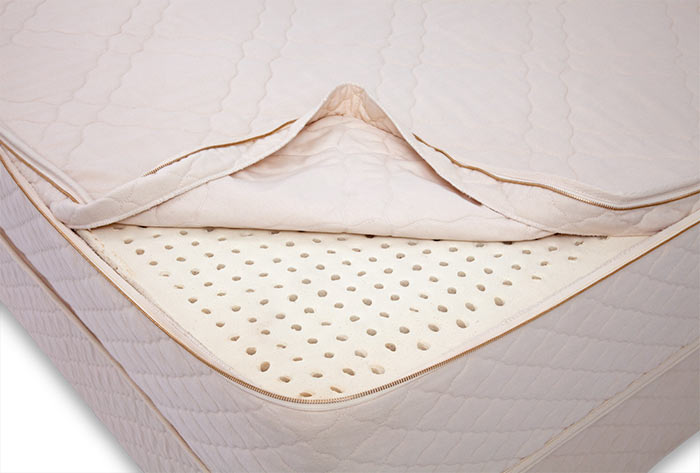
 Editor’s Note
Editor’s Note
Some stains you have to be careful of the temperature of water you use. For instance, protein stains like sperm or blood stains, cold water is recommended.
Warm water will make the stain cling to the mattress more, the opposite of what you want!
Do Enzyme Cleaners Help Clean Urine Off Latex Mattresses?
Yes, enzyme cleaners help clean urine off a mattress by breaking down molecules that contain protein, such as urine, blood stains, and vomit.
We recommend UK brands like:
As always, refer to the instruction manualfor safe application. But the general best practice includes starting with small amounts and testing on a small area to check for an adverse reaction.
Can A Latex Mattress Get Mouldy?
Yes, a latex mattress can have mould and mildew grow on it. While natural latex has natural resistance, external factors such as excessive sweating, big spills not cleaned up and high humidity can promote mould growth.
Here are some tips to reduce the chance of that happening and what to watch out for:
- Make sure the wood on your bed platform is dry before putting your mattress on.
- Solid bed foundations or no-frame beds promote no airflow and builds up moisture.
- Spills or liquid accidents unattended
- Leaving your wet towel on your bed for long durations
- Not letting your mattress dry properly after cleaning
Latex mattresses are not entirely waterproof, even though they’re made from rubber. They have tiny pores, similar to memory foam, where moisture can seep when a spillage is not immediately clean up and mould can thrive.
Use the mild detergent and cold water method we shared earlier to deal with minor mould growth. Remember that we have to avoid using cleaners with strong chemicals like benzyl alcohol, chlorine, or bleach when cleaning latex.
Can I Sun Dry A Latex Mattress?
No, do not sun dry a latex mattress. Latex loses over 55% of it’s tensile strength when exposed to long-periods of UV. This means the elasticity or stretchability of the latex is compromised, making it less bouncy and comfy.
This is further backed-up by mattress brands like Una Mattress warning users not to expose their latex mattresses directly to the sun. In their warning they state that “extreme heat and strong UV rays can damage latex material.”
Heat and UV rays can accelerate the oxidation process of latex and may cause it to dry out, flake, crack or get discoloured.
Can I Steam Clean Latex Mattress?
No, you should not steam clean a latex mattress. According to a study, steam cleaning can prematurely degrade latex with the hot temperatures it goes up to. If you really want to risk it, we’d recommend using the lowest setting.
How To Dry A Wet Latex Mattress?
As you’re unable to sun-dry a latex mattress, what other methods are available to dry your latex mattress:
- Air-Dry Your Mattress Without Sunlight – You can still air dry your latex mattress but away from direct sunlight. Whilst it’ll take longer it still works, just make sure to open up a few windows to keep the room well ventilated.
- Use An Electric Fan – Using an electric fan is speedier than air drying. But using a hairdryer is not recommended, especially with a hot setting. As mentioned, extreme heat can damage the latex.
- Use Baking Soda To Absorb Moisture – Baking soda absorbs moisture on the mattress surface. To do this, sprinkle 3-4 tablespoons on the moist surface, leave it sit for an hour or longer to let the moisture soak up and remove the baking soda off using a vacuum and dry towel.
How To Maintain A Latex Mattress?
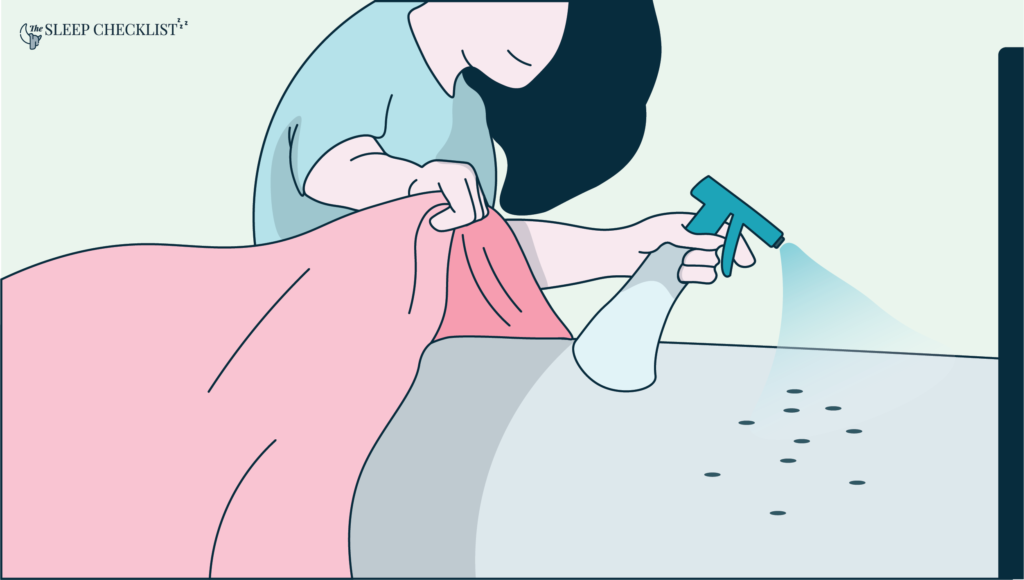
Here are a few tips to keep your mattress from mould growth, sagging and indentations:
- Spot clean stains or spills immediately.
- Use a vacuum cleaner to remove dirt and debris from the cover.
- Use a mattress protector.
- Use a mattress topper.
- Flip or rotate regularly, but ensure it’s in accordance to the manufacturer’s instructions
How Often Should You Clean A Latex Foam Mattress?
We recommend cleaning your latex mattress regularly, once every month – that’s 12 times a year. This will help keep tough stains from becoming permanent and ensure allergens are kept to a minimum.
How Long Should A Latex Mattress Last When Cleaned Regularly?
A latex mattress can last up to 20 years with proper care and maintenance. Signs such as deteriorating material, sagging and mould infestation are the signs you need a new mattress.
Latex mattress brands like Latex Sense and Eco Terra offer a 15-year warranty on their mattresses. Some brands like Ghost Bed and Latex for Less provide a 20-year warranty.
The Road To A Nice Clean Latex Mattress
Latex mattresses are made up of natural materials that should be cleaned with care to avoid damage to the material. In cleaning a latex mattress, harsh cleaners like bleach should be avoided. Opt for mild and eco-friendly cleaners like baking soda, vinegar, mild detergent, and natural enzyme cleaners.
Extreme heat can also damage and dry out the latex material. Avoid exposure to direct sunlight and use heated appliances on latex mattresses.
5 Sources
- https://allergomedik.com/en/allergies-and-dust-mites-statistics
- McCay, S., & Mahlberg, P. (1973). Study of antibacterial activity and bacteriology of latex from Asclepias syriaca L. Antimicrobial agents and chemotherapy, 3(2), 247–253.
https://www.ncbi.nlm.nih.gov/pmc/articles/PMC444395/ - National Research Council (US) Committee on Acute Exposure Guideline Levels. Acute Exposure Guideline Levels for Selected Airborne Chemicals: Volume 6. Washington (DC): National Academies Press (US); 2008. 2, Ammonia Acute Exposure Guideline Levels. Available from:
https://www.ncbi.nlm.nih.gov/books/NBK207883/ - Weiner, I. D., Mitch, W. E., & Sands, J. M. (2015). Urea and Ammonia Metabolism and the Control of Renal Nitrogen Excretion. Clinical journal of the American Society of Nephrology : CJASN, 10(8), 1444–1458.
https://www.ncbi.nlm.nih.gov/pmc/articles/PMC4527031/ - Examining the Effect of UV on Latex and Nitrile Glove Degradation
https://digitalcommons.unl.edu/cgi/viewcontent.cgi?article=1240&context=envstudtheses#:~:text=Latex%20was%20more%20greatly%20affected,to%20breakage%20decreased%20by%2046%25.





